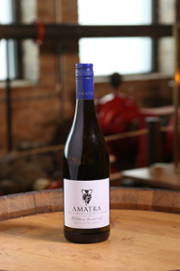- Analysis
- Vineyards
- Vinification and Aging
- Tasting Notes
- 2014 Vintage Notes
Catherine Marshall 2014 Amatra Jono’s Wave Chenin Blanc
Wine of Origin
Elgin
Varietals
100% Chenin Blanc
Analysis
Wine Maker: Catherine Marshall
Alcohol: 14%
Total Acidity: 5.7 g/l
pH: 3.43
Residual Sugar: 2.0 g/l
Total Production: 340 cases
Grapes are selected from a single vineyard in the Elgin Valley and grown on Bokkeveld Shales. Vines are vertically-shoot positioned on a five wire fence system planted 2.2m x 1.2m apart on south and south-east facing slopes to enhance more even budburst and resultant ripening. Production at harvest averages 6-8 tons per hectare which is handpicked and sorted mostly in the vineyard in early March into small17kg batches.
Both cluster and berry sorting commences prior to being partially crushed. The mash is pressed in a pneumatic bag pressed where both free run and pressed fractions are treated oxidatively with minimal chemical applications.
The juice is settled cold for two days and then 40% is decanted to old French casks and the remaining 60% is fermented a steel tank for a month. Both components are fermented spontaneously and only 10% of the entire blend is taken through secondary Malo-Lactic fermentation to broaden out the mid palate. The resultant wine is then further matured for 8 months.
The wine shows intense aromatics of fresh peach and caramelized pineapple. Secondary notes of marzipan and lemon curd with a fresh and crunchy green apple like acidity fans out the tail on the finish. A rich mid palate adds breadth to the graphite and wet stone texture throughout. This wine would pair very well with sushi, seared cape salmon, steamed mussels with saffron, or a fragrantly spiced pork loin with couscous.
An exceptionally wet and cold winter resulted in excellent winter dormancy. Further wet and cold conditions continued late into spring, delaying budburst by several weeks. Although disease pressure was higher, the warmer weather that eventually arrived in December enabled the vines to recover. A wet January led into a warm, sunny February which allowed version to proceed late.

